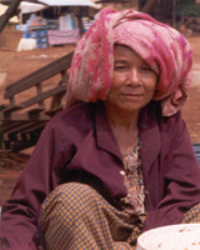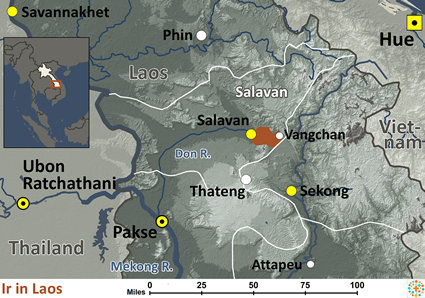The East Katuic language group consists of a number of separate tribes living in southern Laos near the border of Vietnam. These groups include the Ir, the Kantu, the Katang, the Lor, the Pacoh, and the Upper Taoih. Although they speak distinct dialects, they all belong to the East Katu branch of the Mon Khmer language family.
Mon Khmer-speaking tribes were the original settlers of this region; however, they were pushed out of the best valley lands in the early centuries by Thai-speaking peoples. Although the Khmer civilization existed before other people groups moved into the region, their power declined after being conquered by the Thai and Vietnamese.
In modern times, Laos has been the location of numerous battles. It has also become the object of political competition between China, Russia and Vietnam. After many invasions by these countries, Laos has finally entered into good relations with its neighbors.
Most of the Ir live in the mountainous regions or highlands where they practice slash and burn farming. Many also hunt and gather to supplement their diets.
Ir families are patrilineal, which means that the line of descent is traced through the males of the family. Villages are made up of extended family units, who usually live in "longhouses" (long, communal dwellings that have central corridors with family compartments on either side). These long houses are built on stilts and strategically organized in geometric patterns as a means of protection. Pigs, chickens and ducks are raised under or near the houses.
Each village is governed by a loosely organized council of elders, one of whom is considered the "village headman." He is the link to the central government, but his role is not clear. In Buddhist settlements, the core of the village is a Buddhist temple where a monk lives.
Ir villagers are largely self-sufficient. They grow their own rice; have their own vegetable gardens; gather fruit from the forests; and fish in the nearby ponds, rivers, or even in the rice fields! Surplus rice and produce can be exchanged in the market for salt and other necessary items.
The overwhelming majority of the Ir tribe adheres to ethnic religionists. Although they may recognize a creator god, they also worship and fear a large group of spirits called phi. These spirits have much influence over the daily activities of the people.
They are known to be very skilled in dealing with the spirits that inhabit the rivers, forests, and mountains. Sacrifices are used to manipulate and appease the phi. The High Katu (or Kantu) were still involved in human sacrifices until recent times.
Ir villagers daily need God's protection over them as they work in the fields laden with bomblets. They also need more education teams that can teach them how to clear the mines. Many of the children play in the fields while their parents work and eventually get injured by the explosions. Medical help, especially with prosthesis and physical therapy, are desperately needed. Perhaps these needs will provide opportunities for Christian medical missionaries to gain access to these people.
Ask the Lord of the harvest to send forth laborers into Laos to live and work among these tribes.
Ask God to raise up prayer teams to break up the soil through intercession.
Ask the Lord to call forth medical missionaries to work among these tribes and share the love of Christ with them.
Scripture Prayers for the Ir in Laos.
| Profile Source: Joshua Project |

























